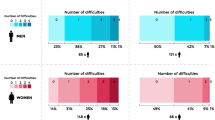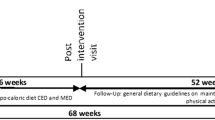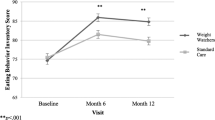Abstract
OBJECTIVE: This study investigated whether baseline eating behavior, emotions, and body image were significant predictors of change in body mass index (BMI) over 6 month and 12 month time intervals for individuals enrolled in a weight loss program that combined appetite suppressant medications and behavior therapy for obesity.
METHOD: Participants were asked to complete self-report questionnaires at baseline, 6 months, and 12 months. In addition, their height and weight were measured and they were administered a body image assessment procedure at each time interval.
RESULTS: At baseline, perceived hunger, dietary restraint, current body size, and trait anxiety were important components in a model for prediction of weight loss at 6 months. Perceived hunger, dietary restraint, and current body size as measured at baseline were important components in the prediction of weight loss at 12 months. These predictive variables, together with gender and initial BMI, accounted for 48.6% of the variance in weight loss at 6 months and 51.7% of the variance in weight loss at 12 months.
DISCUSSION: These findings suggest that scores on certain paper and pencil tests may be useful as predictors of success or failure for individuals entering a weight loss program using pharmacological and behavioral interventions.
This is a preview of subscription content, access via your institution
Access options
Subscribe to this journal
Receive 12 print issues and online access
$259.00 per year
only $21.58 per issue
Buy this article
- Purchase on Springer Link
- Instant access to full article PDF
Prices may be subject to local taxes which are calculated during checkout
Similar content being viewed by others
References
Bray GA, Blackburn GL, Ferguson JM, Greenway FL, Jain AK, Mendel CM, Mendels J, Ryan DH, Schwartz SL, Scheinbaum ML, Seaton TB . Sibutramine produces dose-related weight loss Obes Res 1999 7: 189–198.
Guy-Grand B, Apfelbaum M, Crepaldi G, Gries A, Lefebvre P, Turner P . International trial of long-term dexfenfluramine in obesity Lancet 1989 11: 1142–1145.
Foster GD, Wadden TA, Swain RM, Stunkard AJ, Platte P, Vogt RA . The Eating Inventory in obese women: clinical correlates and relationship to weight loss Int J Obes Relat Metab Disord 1998 22: 778–785.
Stunkard, AJ, Messick, S . Eating inventory manual Psychological Corporation: New York 1988.
Herman CP, Polivy J . Restrained eating In: Stunkard AJ (ed). Obesity Saunders: Philadelphia, PA 1980 208–225.
Heatherton TF, Polivy, J . Chronic dieting and eating disorders: A spiral model. In: Crowther JH, Tannenbaum DL, Hobfoll SE, Stephens MAP (eds). The etiology of bulimia nervosa: the individual and family context Hemisphere: Washington, DC 1992 133–155.
Ryan DH, Bray GA, Helmcke F, Snader G, Volaufova J, Greenway F, Subramaniam P, Glancy DL . Serial echocardiographic and clinical evaluation of valvular regurgitation before, during, and after treatment with fenfluramine or dexfenfluramine and mazindol or phentermine Obes Res 1999 7: 313–322.
Beck AT, Ward C, Mendelson M, Mock J, Erbaugh J . An inventory for measuring depression Arch Gen Psychiat 1961 4: 561–571.
Speilberger CD, Gorsuch RL, Lushene RE . Manual for the state-trait anxiety inventory Consulting Psychologists Press: Palo Alto, CA 1970.
Williamson DA, Womble LG, Zucker NL, Reas DL, White MA, Blouin DC, Greenway F . Body Image Assessment for Obesity (BIA-O): development of a new measure Int J Obes Relat Metab Disord 2000 24: 1326–1332.
Williamson DA, Davis CJ, Bennett SM, Goreczny AJ, Gleaves DH . Development of a simple procedure for assessing body image disturbances Behav Assess 1989 11: 433–446.
Schlundt DG, Hill JO, Pope-Cordle J, Arnold D, Virts KL, Katahn M . Randomized evaluation of a low fat ad libitum carbohydrate diet for weight reduction Int J Obes Relat Metab Disord 1993 17: 623–629.
Blair AJ, Lewis VJ, Booth DA . Does emotional eating interfere with success in attempts at weight control? Appetite 1990 15: 151–157.
Weintraub M, Ginsberg G, Stein EC, Sundaresan PR, Schuster B, O'Connor P, Byrne LM . Phenylpropanolamine OROS (Acutrim) vs placebo in combination with caloric restriction and physician-managed behavior modification Clin Pharm Ther 1986 39: 501–509.
Weintraub M, Taves DR, Hasday JD, Mushlin AI, Lockwood DH . Clin Pharm Ther 1981 30: 528–533.
Neter J, Wasserman W, Kutner MH . Applied linear statistical models 3rd edn, Richard D. Irwin: Boston, MA 1990.
Author information
Authors and Affiliations
Corresponding author
Rights and permissions
About this article
Cite this article
Womble, L., Williamson, D., Greenway, F. et al. Psychological and behavioral predictors of weight loss during drug treatment for obesity. Int J Obes 25, 340–345 (2001). https://doi.org/10.1038/sj.ijo.0801551
Received:
Revised:
Accepted:
Published:
Issue Date:
DOI: https://doi.org/10.1038/sj.ijo.0801551
Keywords
This article is cited by
-
Differential mechanisms affecting weight loss and weight loss maintenance
Nature Metabolism (2023)
-
The effect of a low-energy food foam on appetite measures during a 1-day reduced-energy meal plan
International Journal of Obesity (2015)
-
Dose‐Dependent Suppression of Hunger by a Specific Alginate in a Low‐Viscosity Drink Formulation
Obesity (2011)
-
Effect of PGX, a novel functional fibre supplement, on subjective ratings of appetite in overweight and obese women consuming a 3-day structured, low-calorie diet
Nutrition & Diabetes (2011)
-
Surgical Treatment of Morbid Obesity: Mid-term Outcomes of the Laparoscopic Ileal Interposition Associated to a Sleeve Gastrectomy in 120 Patients
Obesity Surgery (2011)



